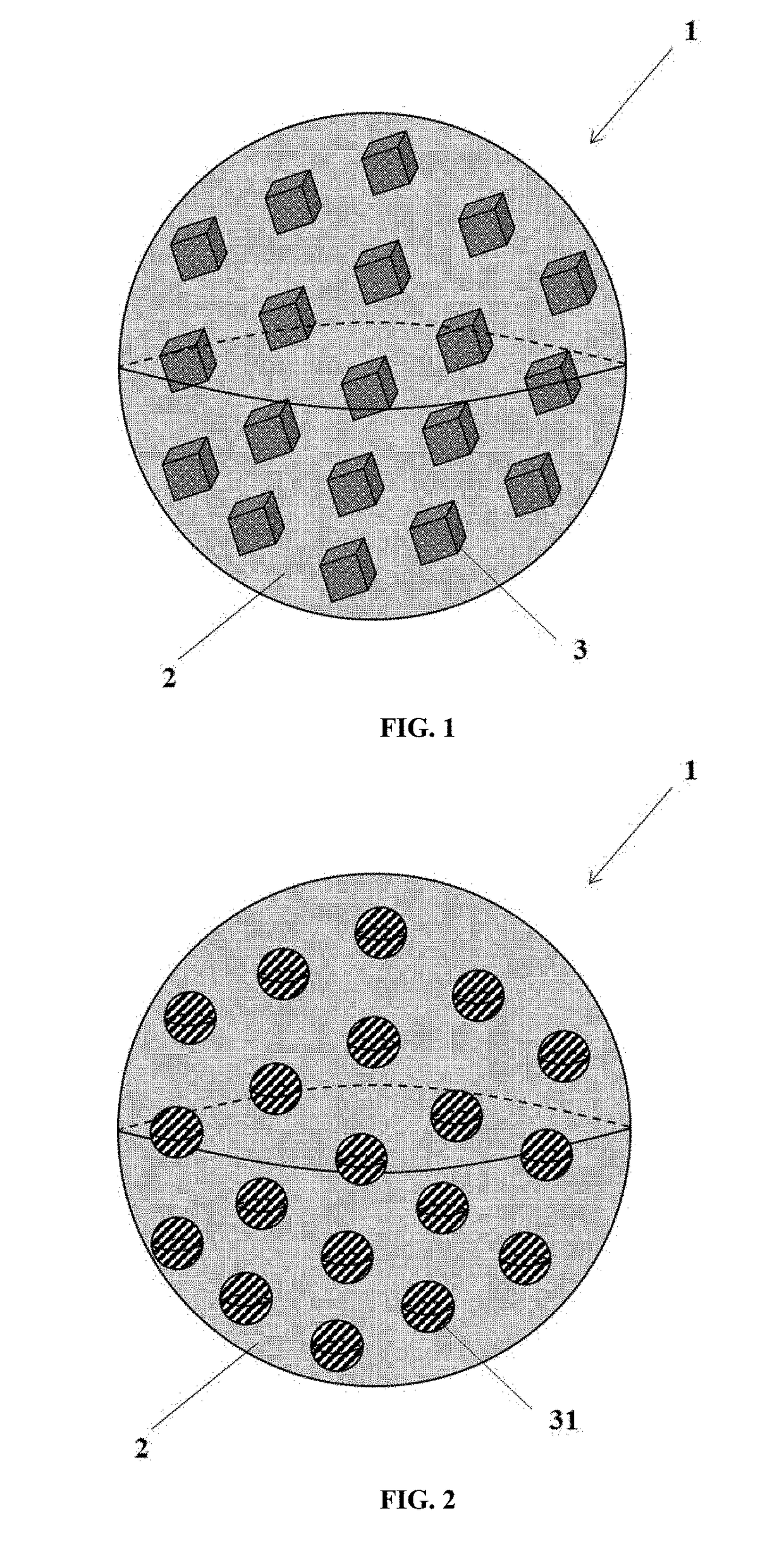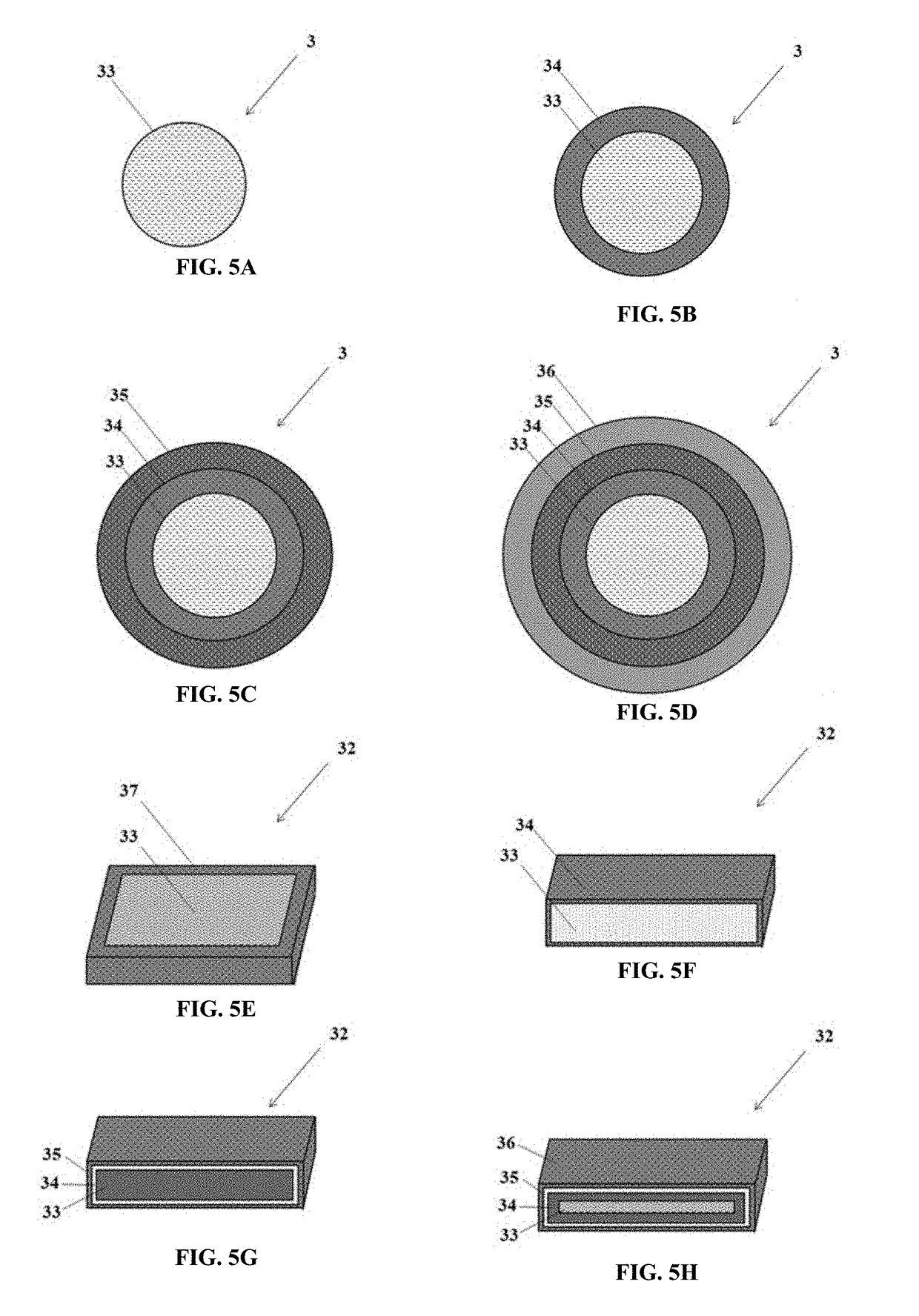Uniformly encapsulated nanoparticles and uses thereof
a technology of uniform encapsulation and nanoparticles, applied in the field of composite particles, can solve the problems of not enabling the long-term performance required for display or lighting devices, ineffective protection of said surface, and not enabling a long-term stability in time and temperatur
- Summary
- Abstract
- Description
- Claims
- Application Information
AI Technical Summary
Benefits of technology
Problems solved by technology
Method used
Image
Examples
example 1
Nanoparticles Preparation
[1796]Nanoparticles used in the examples herein were prepared according to methods of the art (Lhuillier E. et al., Acc. Chem. Res., 2015, 48 (1), pp 22-30; Pedetti S. et al., J. Am. Chem. Soc., 2014, 136 (46), pp 16430-16438; Ithurria S. et al., J. Am. Chem. Soc., 2008, 130, 16504-16505; Nasilowski M. et al., Chem. Rev. 2016, 116, 10934-10982).
[1797]Nanoparticles used in the examples herein were selected in the group comprising CdSe / CdZnS, CdSe, CdS, CdTe, CdSe / CdS, CdSe / ZnS, CdSe / CdZnS, CdS / ZnS, CdS / CdZnS, CdTe / ZnS, CdTe / CdZnS, CdSeS / ZnS, CdSeS / CdS, CdSeS / CdZnS, CuInS2 / ZnS, CuInSe2 / ZnS, InP / CdS, InP / ZnS, InZnP / ZnS, InP / ZnSeS, InP / ZnSe, InP / CdZnS, CdSe / CdZnS / ZnS, CdSe / ZnS / CdZnS, CdSe / CdS / ZnS, CdSe / CdS / CdZnS, CdSe / ZnSe / ZnS, CdSeS / CdS / ZnS, CdSeS / CdS / CdZnS, CdSeS / CdZnS / ZnS, CdSeS / ZnSe / ZnS, CdSeS / ZnSe / CdZnS, CdSeS / ZnS / CdZnS, CdSe / ZnS / CdS, CdSeS / ZnS / CdS, CdSe / ZnSe / CdZnS, InP / ZnSe / ZnS, InP / CdS / ZnSe / ZnS, InP / CdS / ZnS, InP / ZnS / CdS, InP / GaP / ZnS, InP / GaP / ZnSe, InP / CdZ...
example 2
Ligands for Phase Transfer in Basic Aqueous Solution
[1798]100 μL of CdSe / CdZnS nanoplatelets suspended in heptane were mixed with 3-mercaptopropionic acid and heated at 60° C. for several hours. The nanoparticles were then precipitated by centrifugation and redispersed in dimethylformamide. Potassium tert-butoxide were added to the solution before adding ethanol and centrifugate. The final colloidal nanoparticles were redispersed in water.
example 3
Ligands for Phase Transfer in Acidic Aqueous Solution
[1799]100 μL of CdSe / CdZnS nanoplatelets suspended in a basic aqueous solution were mixed with ethanol and centrifugated. A PEG-based polymer was solubilized in water and added to the precipitated nanoplatelets. Acetic acid was dissolved in the colloidal suspension to control the acidic pH.
Example 4: Composite Particles Preparation from a Basic Aqueous Solution—CdSe / CdZnS@SiO2
[1800]100 μL of CdSe / CdZnS nanoplatelets suspended in a basic aqueous solution were mixed with a basic aqueous solution of TEOS at 0.13M previously hydrolyzed for 24 hours, then loaded on a spray-drying set-up. The liquid mixture was sprayed towards a tube furnace heated at a temperature ranging from the boiling point of the solvent to 1000° C. with a nitrogen flow. The composite particles were collected at the surface of a filter.
[1801]FIG. 10 A-B show TEM images of the resulting particles.
[1802]FIG. 11 A shows the N2 adsorption isotherm of the resulting pa...
PUM
| Property | Measurement | Unit |
|---|---|---|
| distance | aaaaa | aaaaa |
| diameter | aaaaa | aaaaa |
| average minimal distance | aaaaa | aaaaa |
Abstract
Description
Claims
Application Information
 Login to View More
Login to View More - R&D
- Intellectual Property
- Life Sciences
- Materials
- Tech Scout
- Unparalleled Data Quality
- Higher Quality Content
- 60% Fewer Hallucinations
Browse by: Latest US Patents, China's latest patents, Technical Efficacy Thesaurus, Application Domain, Technology Topic, Popular Technical Reports.
© 2025 PatSnap. All rights reserved.Legal|Privacy policy|Modern Slavery Act Transparency Statement|Sitemap|About US| Contact US: help@patsnap.com



